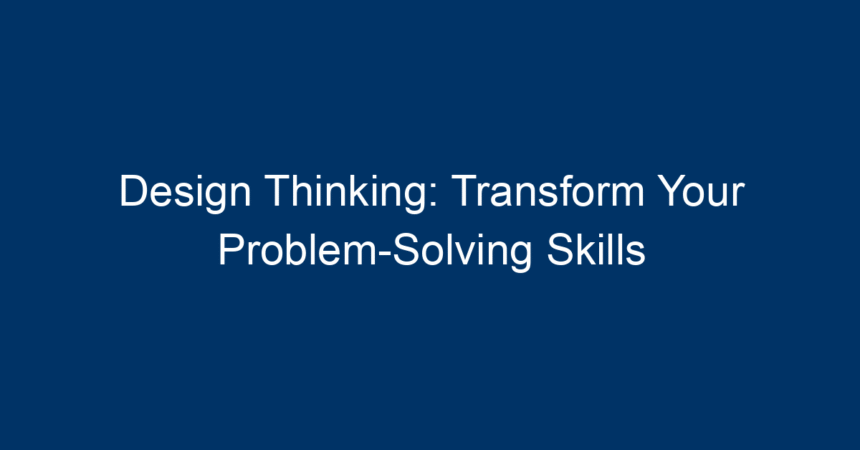In a rapidly evolving world, the ability to adapt and innovate is paramount. Enter design thinking–a transformative approach that empowers individuals and teams to tackle complex challenges creatively. By placing human needs at the forefront of the problem-solving process, design thinking fosters innovation and leads to practical solutions that resonate deeply with users. Whether you’re in business, education, or a creative field, honing your design thinking skills can elevate your problem-solving abilities and drive impactful change.
What is Design Thinking?
Understanding the Concept
Design thinking is a user-centered methodology that combines empathy, creativity, and rationality to address problems. It encourages a hands-on approach to ideation, promoting experimentation and iterative testing. The core of design thinking revolves around understanding users’ needs intimately and crafting solutions that fulfill those needs effectively.
Key Principles of Design Thinking
-
Empathy: Understanding the users’ perspectives, experiences, and challenges is fundamental in design thinking. This requires deep listening and observation.
-
Define: After gathering insights, the next step is to clearly articulate the problem. Framing the challenge accurately helps in generating targeted solutions.
-
Ideate: Brainstorming sessions allow for the exploration of numerous ideas without constraints. This phase encourages creativity and out-of-the-box thinking.
-
Prototype: Creating low-fidelity representations of ideas helps in visualizing concepts and gathering user feedback.
- Test: Iterative testing and refinement based on user feedback fuels the evolution of solutions, ensuring they meet the real needs of users.
The Design Thinking Process
Stage 1: Empathize
At the heart of design thinking is empathy. To genuinely understand users, you must engage with them through interviews, surveys, and observations. This process enables you to immerse yourself in their experiences and gather important insights that will shape your solutions.
Tip: Use empathy maps to visualize user feelings, thoughts, and behaviors, making it easier to identify key pain points.
Stage 2: Define
Once you have gathered insights, the next crucial phase is to define the core problem. Crafting a problem statement is essential—it should be concise, human-centered, and focused. For example, rather than stating, “The product isn’t selling,” you might articulate, “Users find the product confusing and don’t understand its benefits.”
Tip: Utilize the "How Might We" questions to frame your problem effectively, leading to innovative solution paths.
Stage 3: Ideate
Now comes the brainstorming phase. Encourage open dialogue where all ideas, no matter how unconventional, are welcomed. Techniques like mind mapping, SCAMPER, or even simple group discussions can spark creativity. In this phase, quantity often outweighs quality.
Tip: Set a timer to encourage rapid idea generation, reducing the pressure and allowing all voices to be heard.
Stage 4: Prototype
With a wealth of ideas at your disposal, the next step is to create prototypes. These need not be elaborate; low-fidelity sketches, storyboards, or even simple role-playing can help visualize the concepts. Prototyping is about making ideas tangible and creating a basis for feedback.
Tip: Don’t aim for perfection. Rapid prototypes help in identifying flaws early, allowing for quick pivots.
Stage 5: Test
Testing prototypes with real users is vital. Collect insights on usability, functionality, and aesthetics. User feedback will guide the next iterations, ensuring that the final solution truly resonates with the target audience.
Tip: Be open to criticism. Each piece of feedback is a stepping stone toward refining your solution.
Benefits of Design Thinking
Enhanced Creativity
One of the most significant benefits of design thinking is its ability to enhance creativity. By encouraging a culture of experimentation and risk-taking, teams can generate innovative solutions that break conventional molds.
Improved Collaboration
Design thinking fosters a collaborative environment where diverse perspectives come together to tackle challenges. This inclusivity promotes team synergy and leads to more robust solutions.
Increased User Satisfaction
When the user’s needs are central to the problem-solving process, the likelihood of producing valuable solutions increases dramatically. Empathy-driven solutions resonate deeply with users, enhancing satisfaction and loyalty.
Agility in Problem-Solving
In today’s fast-paced world, agility is key. The iterative nature of design thinking allows teams to pivot quickly based on user feedback, ensuring that solutions remain relevant and effective.
Real-World Applications
Business Innovation
Many forward-thinking companies like Apple, Google, and IBM have integrated design thinking into their innovation processes. They use it to create products and services that are not only functional but delightful, ensuring customer satisfaction and loyalty.
Education
Educational institutions are increasingly adopting design thinking to foster creativity and problem-solving among students. By encouraging students to empathize with real-world issues, schools can cultivate a new generation of innovative thinkers.
Healthcare
In healthcare, design thinking has been utilized to improve patient experiences and streamline processes. By understanding the patients’ journey, healthcare providers can create systems that enhance well-being and satisfaction.
Taking Action: Implementing Design Thinking in Your Life
Start Small
You don’t need to overhaul your entire problem-solving process to start utilizing design thinking. Begin with small projects or problems in your daily life. Practice empathy by observing how people interact with products or services.
Embrace Feedback
Cultivate an open mindset towards criticism. Actively seek feedback from peers or users to refine your ideas and prototypes. Remember, improvement comes from learning.
Foster a Creative Environment
Encourage brainstorming sessions in your work or study groups. Create an environment where all ideas are valued, allowing creativity to thrive.
Continuous Learning
Design thinking is an evolving process. Keep reading, attending workshops, or engaging in online courses focused on enhancing your understanding and application of design thinking principles.
Conclusion
Design thinking is more than just a methodology; it’s a mindset that emphasizes empathy, creativity, and collaboration. By adopting this transformative approach, you can significantly enhance your problem-solving skills and drive meaningful change in your work and personal life. Start embracing design thinking today, and watch how it elevates your ability to create user-centered solutions that address real-world challenges. Whether you’re looking to innovate in business, education, or beyond, design thinking can be your key to discovering new possibilities and delivering impactful results. Embrace the journey and let design thinking guide you towards success!




